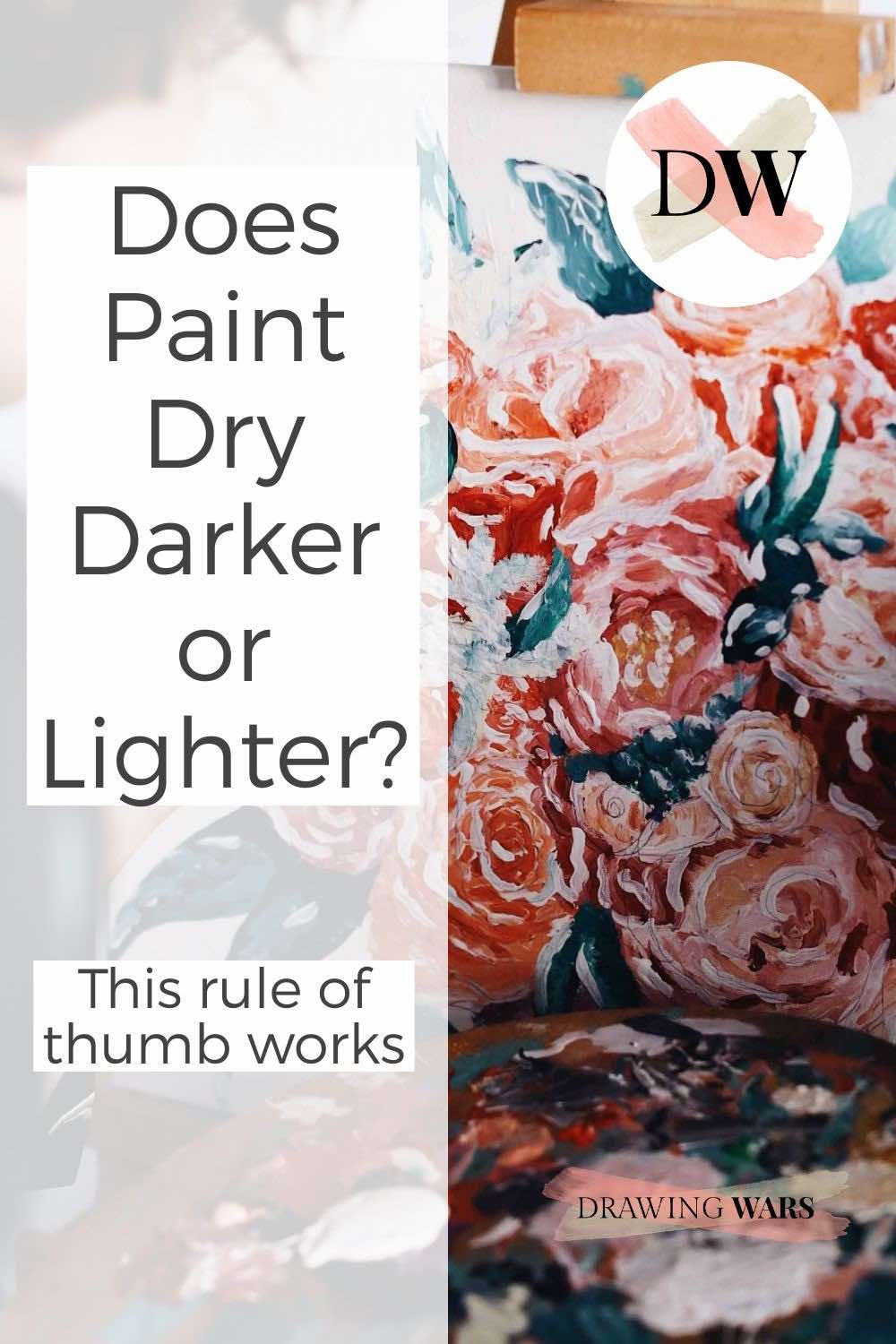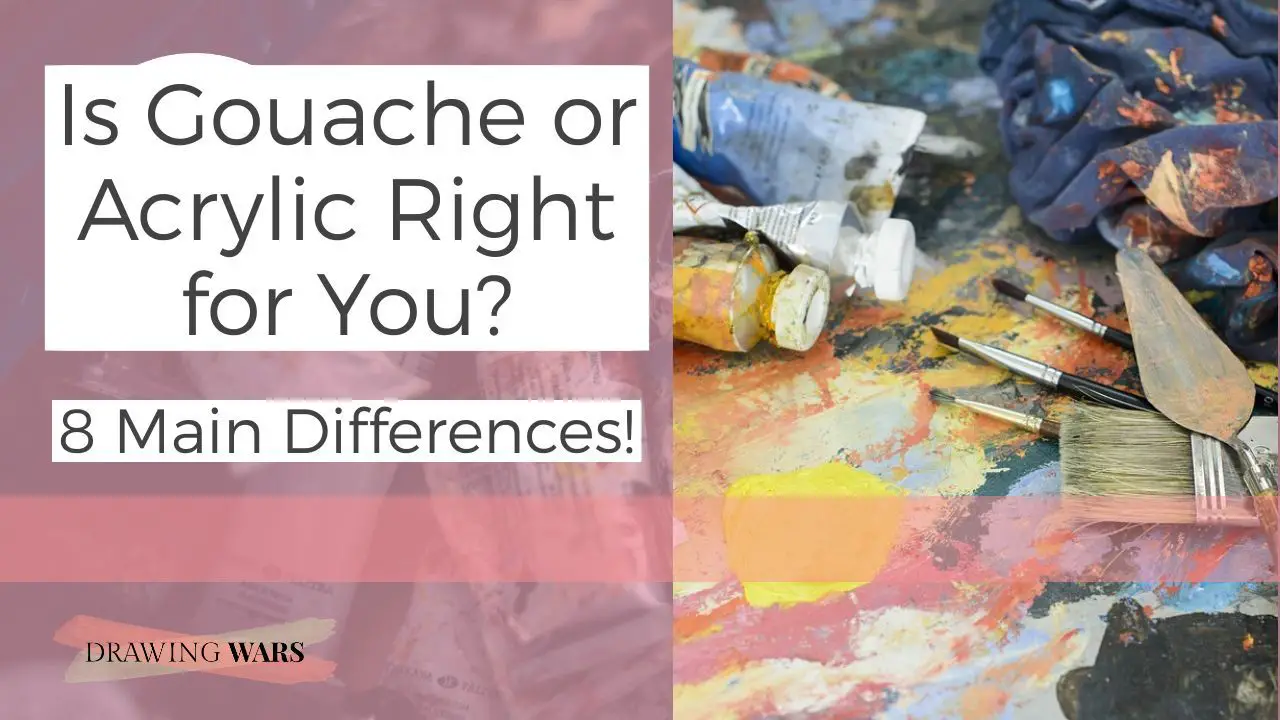

Introduction
The more colors, the merrier. But painting can get quite tricky before and after it has dried. When we first tried painting, we were thrilled when we began to mix colors and applying them on the support. However, once the paint started drying up, we could notice our entire artwork changing. This holds true for most of the painting media, except oil, so handling the paint requires a lot of practice and at most times, even trial and error before getting the right colors for the painting.
Some painting media dry darker compared to others, whereas some dry lighter or remain consistent. Generally, oil paints dry with the same consistency, acrylics dry darker, whereas gouache and watercolor paints dry lighter.
Does watercolor dry darker or lighter?
Watercolor dries lighter than you think!

Watercolor dries lighter in contrast to the tone, tint or shade that is applied while the paint is wet.
Watercolor paints dry lighter so applying a tone or shade that’s one value darker would help. To do that, you would also need to apply less water for the color to remain one tone or shade darker. There are other methods to obtain a darker shade, but that involves mixing of complementary colors to achieve darker tones.
WARNING!
adding white
Adding white watercolor can result in a lighter tone. However, the color in which you're mixing white would become less transparent. This could prevent from forming layers and also lessen the ability of light to reflect through the painting.
If you’re looking for a compact watercolor paint kit, this sketchers’ box will fulfill your stationary as well as traveling needs!
Winsor & Newton Cotman Sketchers' Pocket Box
This compact box consists of 12 half-pans, along with a small brush just the right size for painting during traveling!
Does acrylic dry darker or lighter?
Acrylics can get quite dark once you’re done with the painting!

Acrylic paints dry darker than when they are applied wet.
For most beginners, acrylics is the go-to medium for canvas painting. Not just that, but you can also use it on various surfaces, ranging from wood to fabric and even glass. But the trickiest part with acrylics is the color.
So when working with acrylic paints, you would have to prepare the color one value lighter than the tone or shade you want. That way after it has dried, the painting won’t end up looking darker than how you would expect it to be.
There are different types of acrylics available in the market.
- Metallic acrylics
- Fluorescent acrylics
- Heavy body acrylics
- Fluid or soft body acrylics
So we suggest that you pick an acrylic paint set according to your technique and the result you want once the painting has dried.
PRO-TIP
for thick-textured acrylic paintings
Do you love creating thick textures with acrylic paints? If yes, then you should get a set of heavy body acrylic paints. Since they are heavier, you could create both textured works with knives and by adding water, you could make them thinner too.
For starters, we recommend getting this soft body acrylic paint kit ! Soft body acrylic paints are very easy to work with and much easier to blend compared to their heavy body counterparts.
Liquitex Professional Soft Body Acrylic Paint
A set of 12 acrylic paints, with pure pigments to fill your paintings with the most striking and attractive colors.
Does gouache dry darker or lighter?
Gouache paints can get lighter after they’ve dried.

Light tones tend to dry darker in gouache paints. Whereas, darker tones always dry lighter.
With gouache paints, the entire game of color gets trickier. You may notice that a light gouache tone dries to a darker shade. On the other hand, a dark shade of gouache paint dries much lighter than expected.
However, the change in color is only apparent when you’re painting a huge area. For smaller portions, the color shift isn’t visible much. Nonetheless, when it comes to color in gouache paints, it’s best to keep these tips in mind:
- When mixing a lighter color, make it darker by adding a bit of the complementary color. If you add black or grey for a dark tone, the color might become too dull or dark at once.
- When mixing a darker color, make it lighter by adding slightly more water or white.
PRO-TIP
use a dropper
In case of adding water to lighten a gouache color, use a dropper instead of adding droplets with a brush. This way, you won't end up spilling water or mixing more than required.
If you’re new to gouache and would love to try out this wonderful painting medium, we suggest you get this amazing designers’ gouache set from Winsor & Newton !
Winsor & Newton Designers' Gouache Set (Set of 6)
This designers' gouache set from Winsor & Newton consists of the 6 primary colors.
Does oil paint dry darker or lighter?
Oil paints were the choice of the masters and they’re still a classic!

Oil paints dry with the exact colors and values as they are applied.
With so many choices out there in the modern world of painting, we may think that oil paints would be replaced. But that is far from the truth, because the colors and values you can achieve with oils are quite realistic.
So if you’re going to prepare a pale peach tone and apply it while it’s wet, it will be the same hue even after it is dried. This quality of oil paints makes it the best and most excellent choice for portraits. Whatever skin tone you prepare with the oil paints, it would remain the same long after it has been dried.
Also, it’s a very forgiving medium because one wipe of turpentine or an odourless spirit, and you can fix the entire painting! And since oil paints take a lot of time to dry, you can go back and make the colors lighter or darker too - it’s up to you!
WARNING!
oil paints can yellow with age
What would happen to an unprotected oil painting? The colors would most likely fade away or yellow with age!
If you’re looking for an oil paint set that’s low maintenance and easy to begin with, we highly recommend getting this kit of water-mixable oil paints !
Royal Talens Cobra Artists' Water Mixable Oil Color Set
This set of 10 water mixable oil paints is perfect for both students and beginners in oil painting. All you need is water and you can start painting any time!
Conclusion
Hence, the type of medium you’re using has an impact on the color of the painting. The only painting medium where the color dries with the same consistency is oil paints. For watercolor, the paint always dries lighter and for acrylics, the paint always dries darker. Whereas for gouache, lighter colors dry darker and darker colors dry lighter so both light and dark tones and shades need to be prepared very carefully. And although oil dries with the same consistency, always remember to protect it with varnish, otherwise the oil painting could easily become yellow with age.
In the end, it all depends on how long you’ve been painting and how good you’re at managing the values of color. If you’re not confident about the results of color and color mixing itself, we recommend that you experiment with swatches on a small piece of paper before applying the color to the painting!
Do you wish to learn more about painting media? Read about the differences between acrylic paints and gouache here .
Is Gouache or Acrylic Right for You? 8 Main Differences!
Do you love using paint with thick textures? Gouache and acrylic paints are two fantastic choices for such painting media.

By Jimena & Iñigo
The Navarro-Rubios
My husband and I are learning how to draw and paint. We wanted to share this learning process with the world and have fun! That's why we created this blog. We'll have drawing contests every week and you'll decide who won that week! Follow along and learn with us!

Jimena & Iñigo
The Navarro-Rubios
My husband and I are learning how to draw and paint. We wanted to share this learning process with the world and have fun! That's why we created this blog. We'll have drawing contests every week and you'll decide who won that week! Follow along and learn with us!











